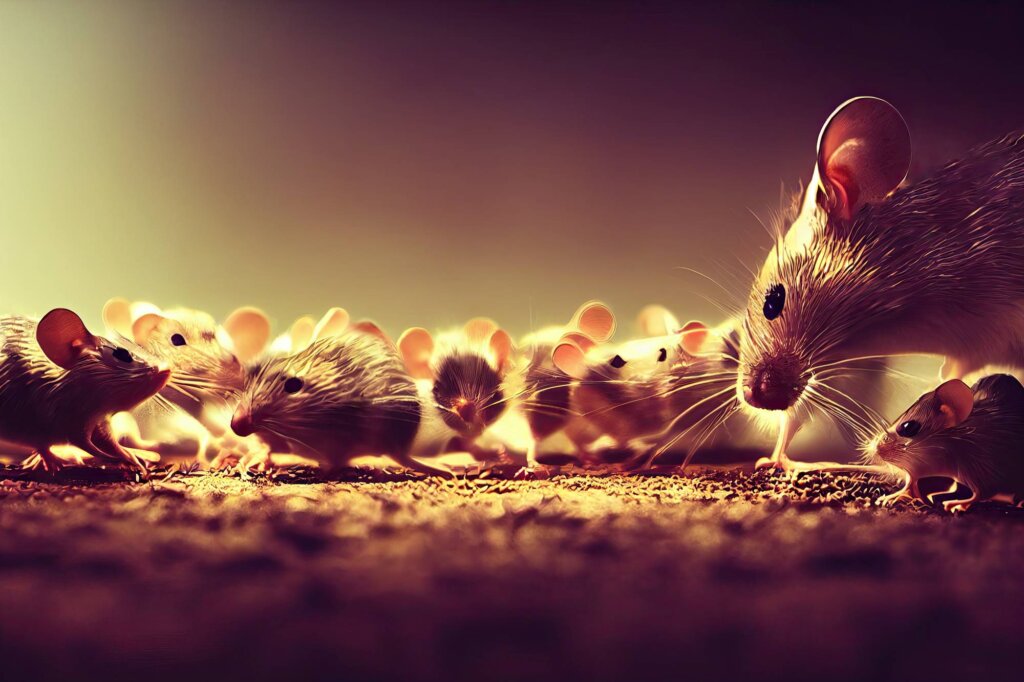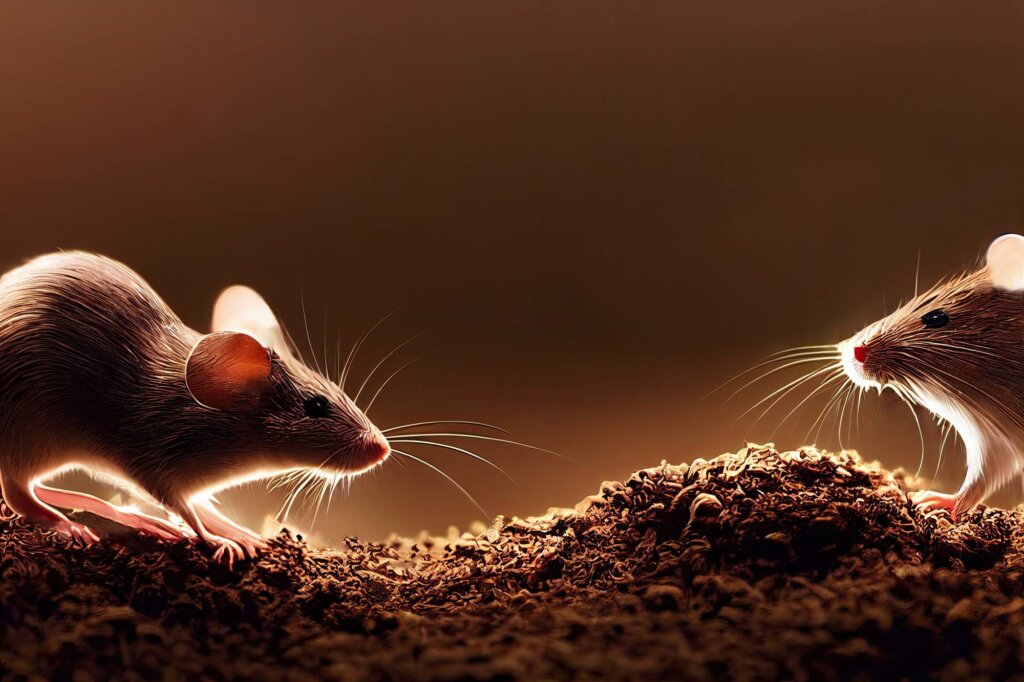Universe 25: An Experiment With Disturbing Results


Written and verified by the psychologist Valeria Sabater
Although Universe 25 might sound like the title of a science fiction novel, it’s actually the name of one of the most important experiments in social psychology. In 1968, the ethologist and biologist John Calhoun built a utopian scenario with mice, to discover the effects of overpopulation. However, five years later, the metropolis was devastated.
What happened during this period demonstrated that the effects of progressive overcrowding can be extremely harmful at all levels. Although conclusions with animal models can’t always be extrapolated to humans, they do often offer thought-provoking references. So, let’s find out about Universe 25, an experiment that was conducted on a Maryland farm.
Universe 25 was initially a garden of Eden for mice. However, over the years, it became a living hell.

The Universe 25 experiment
John Calhoun was an ethologist who worked for much of his life for the US National Institute of Mental Health. In the mid-20th century, overpopulation and overcrowding were of great concern to the scientific community. This researcher had been addressing these issues since the 1950s.
In 1968, Calhoun commenced the experiment known as Universe 25 on a rural property in Poolesville, Maryland. His objective was to study behavior in the context of the overpopulation of a species. For this purpose, he built a veritable Garden of Eden for the mice, with multiple nesting areas and constant sources of food and water.
It was a kind of metallic corral with tunnels. It measured 2.7 meters wide by 1.4 meters high. The mice had everything they needed, except space. Now, let’s find out the results.
From the Garden of Eden to extinction
In 1968, four pairs of mice were introduced into the habitat. Over time, every 55 days, the number of births doubled. By month 19 of the experiment, there were 2,200 mice. This reproductive rhythm was explained by the absence of predators and permanent access to food.
It appeared to be an ideal society. However, certain phenomena of great interest to the field of social psychology occurred. They were as follows:
- Hierarchies were established. Dominant alpha males controlled female harems.
- Mice that lost fights with the dominant males created groups of ‘breakaways’.
- Fights were constant. That was until the alpha males stopped defending their groups of females.
- The females had to initiate defense behaviors for their young. But, the levels of violence were so high that they ended up abandoning or neglecting their offspring.
- Between days 315 and 600, aberrant behaviors occurred that broke the social structure.
- The females became aggressive and many stopped getting pregnant.
- Compulsive sexual behavior occurred. This included mating between mice of the same sex.
- There were incidences of cannibalism.
- The mice stopped creating social ties.
- From day 600, they stopped reproducing and defending their territories. In fact, they limited themselves to carrying out basic tasks for their health, like feeding and grooming.
- The population, faced with the total breakdown of all social patterns, gradually became extinct.
In 1973, less than five years after the start of the experiment, the population went from 2,200 mice to none.
The young that were born into the chaotic environment dominated by violence received no protection. Nor did they establish bonds between them. This ultimately led to total extinction.
The conclusions of the experiment
Dr. Calhoun didn’t hesitate to anthropomorphize the behavior of the mice. For example, throughout the experiment, he classified them as juvenile delinquents and social deserters. Later, his terminology was criticized. Calhoun’s study was published in the journal, The Royal Society of Medicine. He came to the following conclusions:
1. The behavioral sink
Calhoun coined a new term. He called the set of aberrant behaviors that appear in crowded conditions and break the social order a behavioral sink. Moreover, he stated that when the number of individuals occupying a space exceeds balance and harmony, three types of responses appear:
- Compulsive and irrational violence.
- Neglect of the most basic bonds. For instance, caring for offspring.
- Withdrawal and isolation of some individuals to focus only on their personal hygiene and subsistence tasks (food). Calhoun called these the ‘beautiful ones’.
2. Some innovative behaviors
The famous experiment also yielded some hopeful data. This was the fact that some mice demonstrated innovative behavior. Indeed, a few of them, faced with a chaotic, threatening, and declining context, created tunnels in order to escape from the hostile environment. Others built higher cubicles so that they wouldn’t have to come into contact with the most crowded and violent areas.
3. Individuals without status
When the mice stopped fighting over their territories, they lost status. The same thing happened with the females once they realized that they couldn’t take care of their young. The environment was so hostile that the social hierarchy fell apart. Moreover, certain social behaviors arose as a reflection of helplessness and abandonment.
When individuals don’t exhibit mature social behaviors, the development of an organization or social community doesn’t occur.
4. A (questionable) analogy of today’s world
John Calhoun presented his work on mouse behavior as an analogy for the world of the time. This was in the 70s and population growth was high. Dr. Edmund Ramsden, from Queen Mary University of London (UK), published an interesting essay regarding the experiment in 2011. He claimed that:
- Calhoun’s studies were presented to reflect on or justify the need for population control, especially in the most disadvantaged communities.
- The experiment should be interpreted with caution. In fact, he started a debate, essentially academic, regarding whether this type of study could be extrapolated to human societies.

From Universe 25 to the human world
Recently, unlike in the 1970s, birth rates have been significantly decreasing in developed countries. In fact, today, we’re an increasingly aging society. Moreover, it’s common for young people to have no interest in sex. So, have we reached Calhoun’s utopian scenario?
Extrapolation from the lab to the real world
This social experiment on overcrowding reminds us that not all the phenomena we observe in the lab with animals can be transferred to the real world. As a matter of fact, like a Rorschach blot: each person sees what they believe.
In addition, outside the lab, there are so many variables influencing interactions that it’s impossible to study them in a controlled environment.
Furthermore, the scenario designed for these mice was artificial. It was made with the clear intention of generating population chaos by delimiting the space available. Perhaps, in a natural environment, the same thing wouldn’t’ve happened.
There’s a bigger problem than overcrowding
The biggest problem with the experiment wasn’t so much the confined space or the overcrowding, but the loss of functions of the individuals. In effect, the abandonment of their roles produced a social imbalance. If this were to be transferred to the human world we’d find ourselves with a similar problem.
When a large number of people are unable to fulfill their functions in society, alienation and social fracturing can appear. Therefore, if, at some point, we lost the ability to comply and execute complex behaviors, due to environmental factors, problems would arise.
Facing current reality
As humans, we have tools to ensure we wouldn’t replicate what happened in Dr. Calhoun’s experiment. Indeed, we have technology, medicine, and an ever-expanding scientific field. We even have the possibility of exploring environments on other planets.
In fact, our intelligence as a species serves a purpose. This is none other than facilitating our innovation to survive in complex scenarios. It’s something we’ve always done successfully.
Although Universe 25 might sound like the title of a science fiction novel, it’s actually the name of one of the most important experiments in social psychology. In 1968, the ethologist and biologist John Calhoun built a utopian scenario with mice, to discover the effects of overpopulation. However, five years later, the metropolis was devastated.
What happened during this period demonstrated that the effects of progressive overcrowding can be extremely harmful at all levels. Although conclusions with animal models can’t always be extrapolated to humans, they do often offer thought-provoking references. So, let’s find out about Universe 25, an experiment that was conducted on a Maryland farm.
Universe 25 was initially a garden of Eden for mice. However, over the years, it became a living hell.

The Universe 25 experiment
John Calhoun was an ethologist who worked for much of his life for the US National Institute of Mental Health. In the mid-20th century, overpopulation and overcrowding were of great concern to the scientific community. This researcher had been addressing these issues since the 1950s.
In 1968, Calhoun commenced the experiment known as Universe 25 on a rural property in Poolesville, Maryland. His objective was to study behavior in the context of the overpopulation of a species. For this purpose, he built a veritable Garden of Eden for the mice, with multiple nesting areas and constant sources of food and water.
It was a kind of metallic corral with tunnels. It measured 2.7 meters wide by 1.4 meters high. The mice had everything they needed, except space. Now, let’s find out the results.
From the Garden of Eden to extinction
In 1968, four pairs of mice were introduced into the habitat. Over time, every 55 days, the number of births doubled. By month 19 of the experiment, there were 2,200 mice. This reproductive rhythm was explained by the absence of predators and permanent access to food.
It appeared to be an ideal society. However, certain phenomena of great interest to the field of social psychology occurred. They were as follows:
- Hierarchies were established. Dominant alpha males controlled female harems.
- Mice that lost fights with the dominant males created groups of ‘breakaways’.
- Fights were constant. That was until the alpha males stopped defending their groups of females.
- The females had to initiate defense behaviors for their young. But, the levels of violence were so high that they ended up abandoning or neglecting their offspring.
- Between days 315 and 600, aberrant behaviors occurred that broke the social structure.
- The females became aggressive and many stopped getting pregnant.
- Compulsive sexual behavior occurred. This included mating between mice of the same sex.
- There were incidences of cannibalism.
- The mice stopped creating social ties.
- From day 600, they stopped reproducing and defending their territories. In fact, they limited themselves to carrying out basic tasks for their health, like feeding and grooming.
- The population, faced with the total breakdown of all social patterns, gradually became extinct.
In 1973, less than five years after the start of the experiment, the population went from 2,200 mice to none.
The young that were born into the chaotic environment dominated by violence received no protection. Nor did they establish bonds between them. This ultimately led to total extinction.
The conclusions of the experiment
Dr. Calhoun didn’t hesitate to anthropomorphize the behavior of the mice. For example, throughout the experiment, he classified them as juvenile delinquents and social deserters. Later, his terminology was criticized. Calhoun’s study was published in the journal, The Royal Society of Medicine. He came to the following conclusions:
1. The behavioral sink
Calhoun coined a new term. He called the set of aberrant behaviors that appear in crowded conditions and break the social order a behavioral sink. Moreover, he stated that when the number of individuals occupying a space exceeds balance and harmony, three types of responses appear:
- Compulsive and irrational violence.
- Neglect of the most basic bonds. For instance, caring for offspring.
- Withdrawal and isolation of some individuals to focus only on their personal hygiene and subsistence tasks (food). Calhoun called these the ‘beautiful ones’.
2. Some innovative behaviors
The famous experiment also yielded some hopeful data. This was the fact that some mice demonstrated innovative behavior. Indeed, a few of them, faced with a chaotic, threatening, and declining context, created tunnels in order to escape from the hostile environment. Others built higher cubicles so that they wouldn’t have to come into contact with the most crowded and violent areas.
3. Individuals without status
When the mice stopped fighting over their territories, they lost status. The same thing happened with the females once they realized that they couldn’t take care of their young. The environment was so hostile that the social hierarchy fell apart. Moreover, certain social behaviors arose as a reflection of helplessness and abandonment.
When individuals don’t exhibit mature social behaviors, the development of an organization or social community doesn’t occur.
4. A (questionable) analogy of today’s world
John Calhoun presented his work on mouse behavior as an analogy for the world of the time. This was in the 70s and population growth was high. Dr. Edmund Ramsden, from Queen Mary University of London (UK), published an interesting essay regarding the experiment in 2011. He claimed that:
- Calhoun’s studies were presented to reflect on or justify the need for population control, especially in the most disadvantaged communities.
- The experiment should be interpreted with caution. In fact, he started a debate, essentially academic, regarding whether this type of study could be extrapolated to human societies.

From Universe 25 to the human world
Recently, unlike in the 1970s, birth rates have been significantly decreasing in developed countries. In fact, today, we’re an increasingly aging society. Moreover, it’s common for young people to have no interest in sex. So, have we reached Calhoun’s utopian scenario?
Extrapolation from the lab to the real world
This social experiment on overcrowding reminds us that not all the phenomena we observe in the lab with animals can be transferred to the real world. As a matter of fact, like a Rorschach blot: each person sees what they believe.
In addition, outside the lab, there are so many variables influencing interactions that it’s impossible to study them in a controlled environment.
Furthermore, the scenario designed for these mice was artificial. It was made with the clear intention of generating population chaos by delimiting the space available. Perhaps, in a natural environment, the same thing wouldn’t’ve happened.
There’s a bigger problem than overcrowding
The biggest problem with the experiment wasn’t so much the confined space or the overcrowding, but the loss of functions of the individuals. In effect, the abandonment of their roles produced a social imbalance. If this were to be transferred to the human world we’d find ourselves with a similar problem.
When a large number of people are unable to fulfill their functions in society, alienation and social fracturing can appear. Therefore, if, at some point, we lost the ability to comply and execute complex behaviors, due to environmental factors, problems would arise.
Facing current reality
As humans, we have tools to ensure we wouldn’t replicate what happened in Dr. Calhoun’s experiment. Indeed, we have technology, medicine, and an ever-expanding scientific field. We even have the possibility of exploring environments on other planets.
In fact, our intelligence as a species serves a purpose. This is none other than facilitating our innovation to survive in complex scenarios. It’s something we’ve always done successfully.
All cited sources were thoroughly reviewed by our team to ensure their quality, reliability, currency, and validity. The bibliography of this article was considered reliable and of academic or scientific accuracy.
- Calhoun, J.B. (1971). Space and the Strategy of Life. In: Esser, A.H. (eds) Behavior and Environment. Springer, Boston, MA. https://doi.org/10.1007/978-1-4684-1893-4_25
- Calhoun JB. (1973). Death Squared: The Explosive Growth and Demise of a Mouse Population. Proceedings of the Royal Society of Medicine, 66(1P2),80-88. doi:10.1177/00359157730661P202
- Freedman, J. L. (1975). Crowding and behavior. W. H. Freedman. https://psycnet.apa.org/record/1976-05842-000
- Ramsden E. (2011). From rodent utopia to urban hell: population, pathology, and the crowded rats of NIMH. Isis; an international review devoted to the history of science and its cultural influences, 102(4), 659–688. https://doi.org/10.1086/663598
This text is provided for informational purposes only and does not replace consultation with a professional. If in doubt, consult your specialist.







